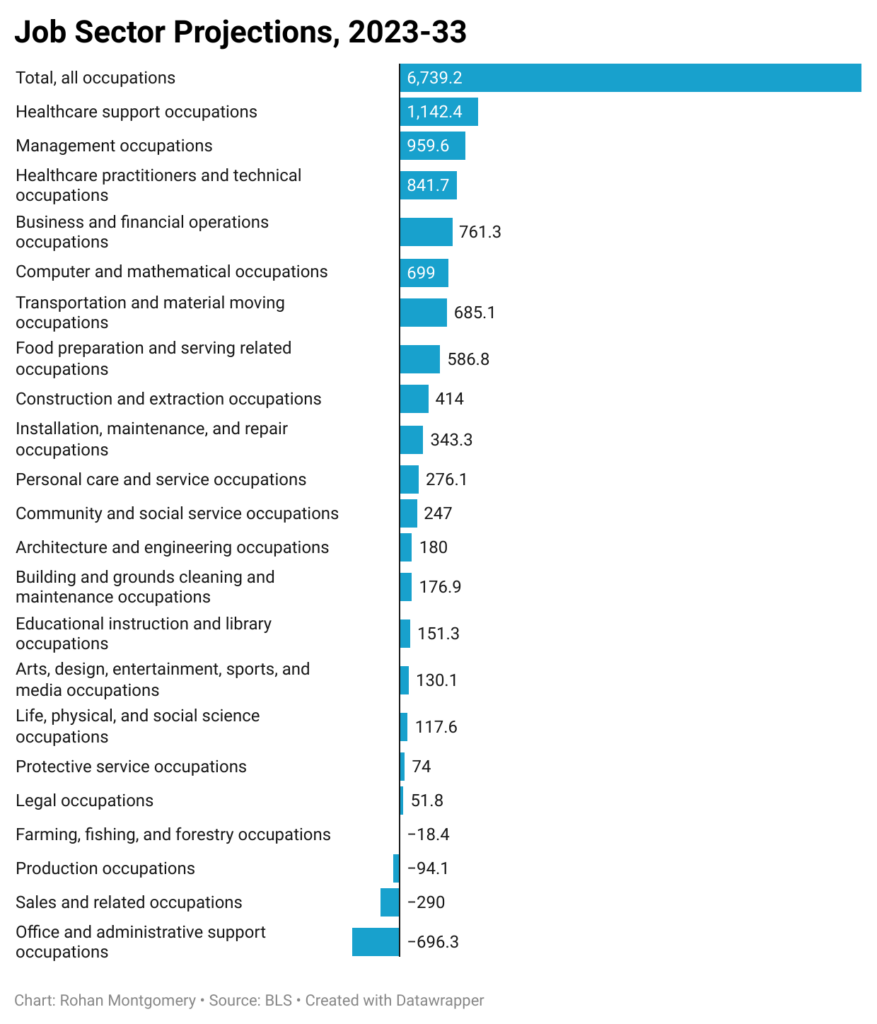The days of spending your entire career at one company might be a rarity now, but the question of what to do for work is just as important as ever before.
Job Sector Headwinds
The rate of technological progress means entire industries could disappear in a matter of decades. Switchboard and elevator operators, for example, are no more.
With the advent of AI, other professions—from copywriting to transcription and beyond—might well be next.
Following your passion is one thing. But committing to a declining industry could be a recipe for struggle. What, then, are the industries experiencing booms?
Fortunately, the Bureau of Labor Statistics keeps track of employment patterns in the U.S. They also publish detailed projections, including estimates of how many jobs will be added in each sector.
In the U.S., a little under 168 million people were employed in 2023. By 2033, the BLS anticipates this number will rise 174.5 million. In other words, some 6.5 million additional jobs will be added to the economy.
Some of these opportunities could be in entirely new job sectors. But many of them will be in industries that already exist.

Healthcare Job Sector
According to the BLS projection, the job sector with the biggest growth will be healthcare support occupations.
This category includes respiratory therapy technicians, pharmacy technicians, pharmacy aides, occupational therapy assistants, and physical therapy assistants.
The good news is that this sector will grow by over 15% throughout the coming decade. That’s over 1.1 million additional jobs.
The bad news, however, is that these jobs aren’t exceptionally well paid. The median salary of healthcare support roles, for example is $36,140—over $10,000 less than the U.S. median salary of $59,228.
In many parts of the U.S., especially in and around major cities, the cost of living has increased to such a degree that a below-median salary simply isn’t enough to live.
Service Industry
Healthcare isn’t the only poorly paid sector that will experience growth over the coming decade.
The personal care and service, transportation and material moving, food preparation and serving, and building and grounds cleaning sectors will collectively add over 1.7 million jobs by 2033.
Like healthcare support, these sectors all have a median salary below the current U.S. median salary. That means, based on the Bureau’s projections, over one-third of the new jobs created this decade will therefore be in sectors with a median salary below the national median salary.
Computer and Mathematical Occupations
Fortunately, there are plenty of highly paid sectors that will also experience significant growth. In fact, the sector with the second largest relative growth will be computer and mathematical occupations.
This sector includes civil engineers, computer scientists, software developers, financial analysts, and other numbers-centric jobs.
According to the BLS, this sector will grow by almost 13%. With a median salary of almost $105,000—over double the U.S. median salary—these jobs are likely to be very well compensated.
Management occupations is the other big-money sector that will experience growth over the coming decade.
Though the BLS thinks it’ll only grow by 7%, the median salary of this sector is a cool $116,000, almost triple the U.S. median salary.
According to the BLS, most job sectors will experience at least some growth over the next 10 years.
In fact, just four of the 22 tracked sectors are expected to shrink: Office and administrative support occupations; sales and related occupations; farming, fishing, and forestry occupations; and production occupations. Over 1 million jobs will be lost in these four job sectors.
Remember, though, that these are just estimates. A lot can happen in ten years, so don’t let these guesses—no matter how informed—completely dictate how you set about building your future.
Related: The Cost and Earning Potential of College Degrees by Major


